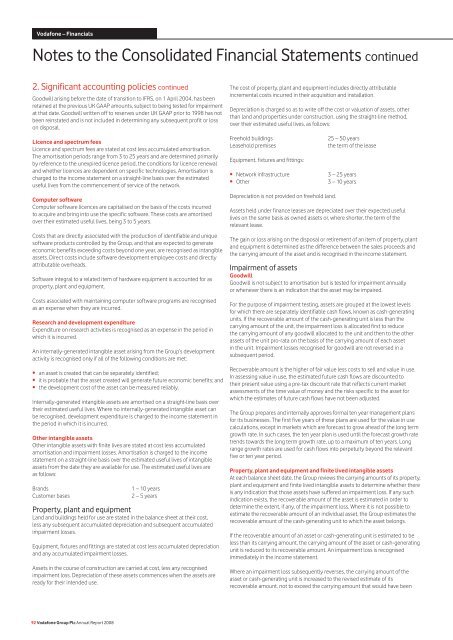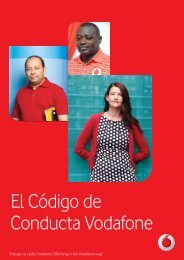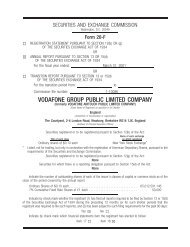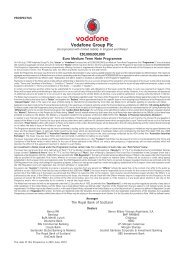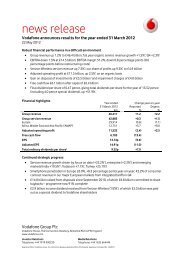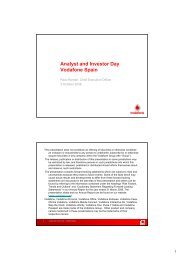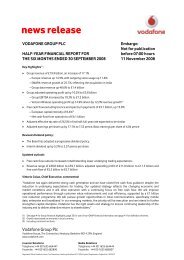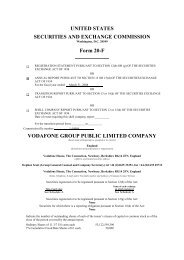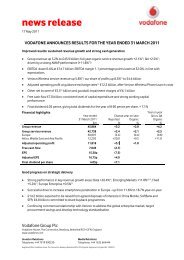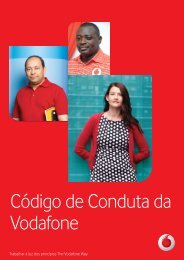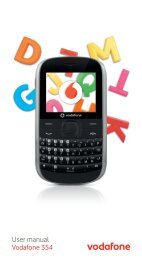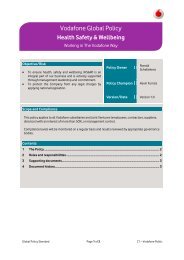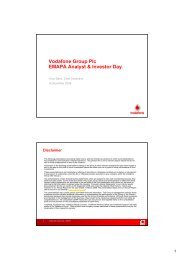Create successful ePaper yourself
Turn your PDF publications into a flip-book with our unique Google optimized e-Paper software.
2. Significant accounting policies continued<br />
Goodwill arising before <strong>the</strong> date of transition to IFRS, on 1 April 2004, has been<br />
retained at <strong>the</strong> previous UK GAAP amounts, subject to being tested for impairment<br />
at that date. Goodwill written off to reserves under UK GAAP prior to 1998 has not<br />
been reinstated and is not included in determining any subsequent profit or loss<br />
on disposal.<br />
Licence and spectrum fees<br />
Licence and spectrum fees are stated at cost less accumulated amortisation.<br />
The amortisation periods range from 3 to 25 years and are determined primarily<br />
by reference to <strong>the</strong> unexpired licence period, <strong>the</strong> conditions for licence renewal<br />
and whe<strong>the</strong>r licences are dependent on specific technologies. Amortisation is<br />
charged to <strong>the</strong> income statement on a straight-line basis over <strong>the</strong> estimated<br />
useful lives from <strong>the</strong> commencement of service of <strong>the</strong> network.<br />
Computer software<br />
Computer software licences are capitalised on <strong>the</strong> basis of <strong>the</strong> costs incurred<br />
to acquire and bring into use <strong>the</strong> specific software. These costs are amortised<br />
over <strong>the</strong>ir estimated useful lives, being 3 to 5 years.<br />
Costs that are directly associated with <strong>the</strong> production of identifiable and unique<br />
software products controlled by <strong>the</strong> Group, and that are expected to generate<br />
economic benefits exceeding costs beyond one year, are recognised as intangible<br />
assets. Direct costs include software development employee costs and directly<br />
attributable overheads.<br />
Software integral to a related item of hardware equipment is accounted for as<br />
property, plant and equipment.<br />
Costs associated with maintaining computer software programs are recognised<br />
as an expense when <strong>the</strong>y are incurred.<br />
Research and development expenditure<br />
Expenditure on research activities is recognised as an expense in <strong>the</strong> period in<br />
which it is incurred.<br />
An internally-generated intangible asset arising from <strong>the</strong> Group’s development<br />
activity is recognised only if all of <strong>the</strong> following conditions are met:<br />
•<br />
•<br />
•<br />
<strong>Vodafone</strong> – Financials<br />
Notes to <strong>the</strong> Consolidated Financial Statements continued<br />
an asset is created that can be separately identified;<br />
it is probable that <strong>the</strong> asset created will generate future economic benefits; and<br />
<strong>the</strong> development cost of <strong>the</strong> asset can be measured reliably.<br />
Internally-generated intangible assets are amortised on a straight-line basis over<br />
<strong>the</strong>ir estimated useful lives. Where no internally-generated intangible asset can<br />
be recognised, development expenditure is charged to <strong>the</strong> income statement in<br />
<strong>the</strong> period in which it is incurred.<br />
O<strong>the</strong>r intangible assets<br />
O<strong>the</strong>r intangible assets with finite lives are stated at cost less accumulated<br />
amortisation and impairment losses. Amortisation is charged to <strong>the</strong> income<br />
statement on a straight-line basis over <strong>the</strong> estimated useful lives of intangible<br />
assets from <strong>the</strong> date <strong>the</strong>y are available for use. The estimated useful lives are<br />
as follows:<br />
Brands 1 – 10 years<br />
Customer bases 2 – 5 years<br />
Property, plant and equipment<br />
Land and buildings held for use are stated in <strong>the</strong> balance sheet at <strong>the</strong>ir cost,<br />
less any subsequent accumulated depreciation and subsequent accumulated<br />
impairment losses.<br />
Equipment, fixtures and fittings are stated at cost less accumulated depreciation<br />
and any accumulated impairment losses.<br />
Assets in <strong>the</strong> course of construction are carried at cost, less any recognised<br />
impairment loss. Depreciation of <strong>the</strong>se assets commences when <strong>the</strong> assets are<br />
ready for <strong>the</strong>ir intended use.<br />
92 <strong>Vodafone</strong> Group Plc Annual Report 2008<br />
The cost of property, plant and equipment includes directly attributable<br />
incremental costs incurred in <strong>the</strong>ir acquisition and installation.<br />
Depreciation is charged so as to write off <strong>the</strong> cost or valuation of assets, o<strong>the</strong>r<br />
than land and properties under construction, using <strong>the</strong> straight-line method,<br />
over <strong>the</strong>ir estimated useful lives, as follows:<br />
Freehold buildings 25 – 50 years<br />
Leasehold premises <strong>the</strong> term of <strong>the</strong> lease<br />
Equipment, fixtures and fittings:<br />
•<br />
•<br />
Network infrastructure 3 – 25 years<br />
O<strong>the</strong>r 3 – 10 years<br />
Depreciation is not provided on freehold land.<br />
Assets held under finance leases are depreciated over <strong>the</strong>ir expected useful<br />
lives on <strong>the</strong> same basis as owned assets or, where shorter, <strong>the</strong> term of <strong>the</strong><br />
relevant lease.<br />
The gain or loss arising on <strong>the</strong> disposal or retirement of an item of property, plant<br />
and equipment is determined as <strong>the</strong> difference between <strong>the</strong> sales proceeds and<br />
<strong>the</strong> carrying amount of <strong>the</strong> asset and is recognised in <strong>the</strong> income statement.<br />
Impairment of assets<br />
Goodwill<br />
Goodwill is not subject to amortisation but is tested for impairment annually<br />
or whenever <strong>the</strong>re is an indication that <strong>the</strong> asset may be impaired.<br />
For <strong>the</strong> purpose of impairment testing, assets are grouped at <strong>the</strong> lowest levels<br />
for which <strong>the</strong>re are separately identifiable cash flows, known as cash-generating<br />
units. If <strong>the</strong> recoverable amount of <strong>the</strong> cash-generating unit is less than <strong>the</strong><br />
carrying amount of <strong>the</strong> unit, <strong>the</strong> impairment loss is allocated first to reduce<br />
<strong>the</strong> carrying amount of any goodwill allocated to <strong>the</strong> unit and <strong>the</strong>n to <strong>the</strong> o<strong>the</strong>r<br />
assets of <strong>the</strong> unit pro-rata on <strong>the</strong> basis of <strong>the</strong> carrying amount of each asset<br />
in <strong>the</strong> unit. Impairment losses recognised for goodwill are not reversed in a<br />
subsequent period.<br />
Recoverable amount is <strong>the</strong> higher of fair value less costs to sell and value in use.<br />
In assessing value in use, <strong>the</strong> estimated future cash flows are discounted to<br />
<strong>the</strong>ir present value using a pre-tax discount rate that reflects current market<br />
assessments of <strong>the</strong> time value of money and <strong>the</strong> risks specific to <strong>the</strong> asset for<br />
which <strong>the</strong> estimates of future cash flows have not been adjusted.<br />
The Group prepares and internally approves formal ten year management plans<br />
for its businesses. The first five years of <strong>the</strong>se plans are used for <strong>the</strong> value in use<br />
calculations, except in markets which are forecast to grow ahead of <strong>the</strong> long term<br />
growth rate. In such cases, <strong>the</strong> ten year plan is used until <strong>the</strong> forecast growth rate<br />
trends towards <strong>the</strong> long term growth rate, up to a maximum of ten years. Long<br />
range growth rates are used for cash flows into perpetuity beyond <strong>the</strong> relevant<br />
five or ten year period.<br />
Property, plant and equipment and finite lived intangible assets<br />
At each balance sheet date, <strong>the</strong> Group reviews <strong>the</strong> carrying amounts of its property,<br />
plant and equipment and finite lived intangible assets to determine whe<strong>the</strong>r <strong>the</strong>re<br />
is any indication that those assets have suffered an impairment loss. If any such<br />
indication exists, <strong>the</strong> recoverable amount of <strong>the</strong> asset is estimated in order to<br />
determine <strong>the</strong> extent, if any, of <strong>the</strong> impairment loss. Where it is not possible to<br />
estimate <strong>the</strong> recoverable amount of an individual asset, <strong>the</strong> Group estimates <strong>the</strong><br />
recoverable amount of <strong>the</strong> cash-generating unit to which <strong>the</strong> asset belongs.<br />
If <strong>the</strong> recoverable amount of an asset or cash-generating unit is estimated to be<br />
less than its carrying amount, <strong>the</strong> carrying amount of <strong>the</strong> asset or cash-generating<br />
unit is reduced to its recoverable amount. An impairment loss is recognised<br />
immediately in <strong>the</strong> income statement.<br />
Where an impairment loss subsequently reverses, <strong>the</strong> carrying amount of <strong>the</strong><br />
asset or cash-generating unit is increased to <strong>the</strong> revised estimate of its<br />
recoverable amount, not to exceed <strong>the</strong> carrying amount that would have been


